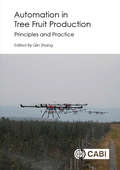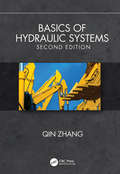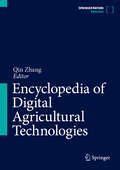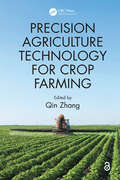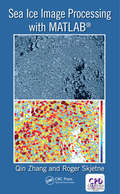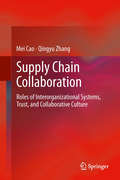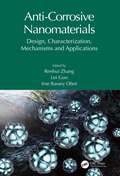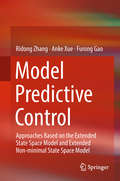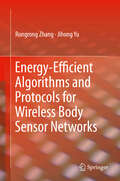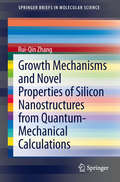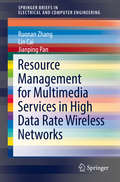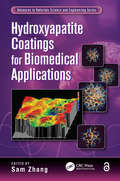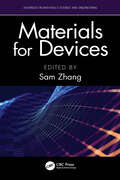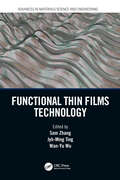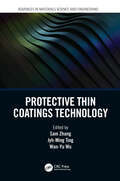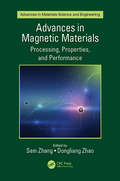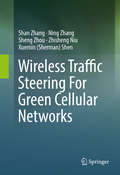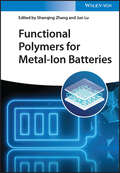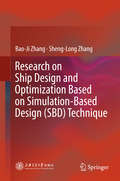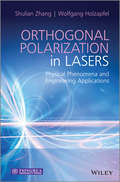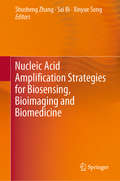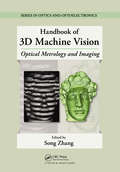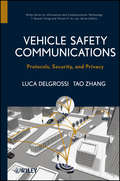- Table View
- List View
Automation in Tree Fruit Production: Principles and Practice
by Qin ZhangThe technology that allows automation in agriculture is rapidly developing and being applied to wide variety of key crops. This book focuses on automation in tree fruit crops worldwide. It covers topics such as automated tree fruit production systems, plant stress sensing and high-throughput phenotyping in precision horticulture, the economics of automation in tree fruit production, light interception sensing systems for canopy management, precision irrigation and water management, precision technologies for pest and disease management, opportunities for the application of robotics in tree fruit production, and the mechanical harvesting and handling of fruit crops.
Basics of Hydraulic Systems, Second Edition
by Qin ZhangThis textbook surveys hydraulics and fluid power systems technology, with new chapters on system modeling and hydraulic systems controls now included.The text presents topics in a systematic way, following the course of energy transmission in hydraulic power generation, distribution, deployment, modeling, and control in fluid power systems.
Encyclopedia of Digital Agricultural Technologies
by Qin ZhangDigital agriculture is an emerging concept of modern farming that refers to managing farms using modern Engineering, Information and Communication Technologies (EICT) aiming at increasing the overall efficiency of agricultural production, improving the quantity and quality of products, and optimizing the human labor required and natural resource consumption in operations. This encyclopedia is designed to collect the summaries of knowledge on as many as subjects or aspects relevant to ECIT for digital agriculture, present such knowledge in entries, and arrange them alphabetically by articles titles.Springer Major Reference Works platform offers Live Update capability. Our reference work takes full advantage of this feature, which allows for continuous improvement or revision of published content electronically.The Editorial BoardDr. Irwin R. Donis-Gonzalez, University of California Davis, Dept. Biological and Agricultural Engineering, Davis, USA (Section: Postharvest Technologies)Prof. Paul Heinemann, Pennsylvania State University, Department Head of Agricultural and Biological Engineering, PA, USA (Section: Technologies for Crop Production)Prof. Manoj Karkee, Washington State University, Center for Precision and Automated Agricultural Systems, Washington, USA (Section: Robotics and Automation Technologies)Prof. Minzan Li, China Agricultural University, Beijing, China (Section: Precision Agricultural Technologies)Prof. Dikai Liu, University of Technology Sydney (UTS),Faculty of Engineering & Information Technologies, Broadway NSW, Australia (Section: AI, Information and Communication Technologies)Prof. Tomas Norton, University of Leuven, Dept. of Biosystems, Heverlee Leuven, Belgium (Section: Technologies for Animal and Aquatic Production)Dr. Manuela Zude-Sasse, Leibniz Institute for Agricultural Engineering and Bioeconomy (ATB), Precision Horticulture, Potsdam, Germany (Section: Engineering and Mechanization Technologies)
Precision Agriculture Technology for Crop Farming
by Qin ZhangThis book provides a review of precision agriculture technology development, followed by a presentation of the state-of-the-art and future requirements of precision agriculture technology. It presents different styles of precision agriculture technologies suitable for large scale mechanized farming; highly automated community-based mechanized production; and fully mechanized farming practices commonly seen in emerging economic regions. The book emphasizes the introduction of core technical features of sensing, data processing and interpretation technologies, crop modeling and production control theory, intelligent machinery and field robots for precision agriculture production.
Sea Ice Image Processing with MATLAB® (Signal and Image Processing of Earth Observations)
by Qin Zhang Roger SkjetneSea Ice Image Processing with MATLAB addresses the topic of image processing for the extraction of key sea ice characteristics from digital photography, which is of great relevance for Artic remote sensing and marine operations. This valuable guide provides tools for quantifying the ice environment that needs to be identified and reproduced for such testing. This includes fit-for-purpose studies of existing vessels, new-build conceptual design and detailed engineering design studies for new developments, and studies of demanding marine operations involving multiple vessels and operational scenarios in sea ice. A major contribution of this work is the development of automated computer algorithms for efficient image analysis. These are used to process individual sea-ice images and video streams of images to extract parameters such as ice floe size distribution, and ice types. Readers are supplied with Matlab source codes of the algorithms for the image processing methods discussed in the book made available as online material. Features Presents the first systematic work using image processing techniques to identify ice floe size distribution from aerial images Helps identify individual ice floe and obtain floe size distributions for Arctic offshore operations and transportation Explains specific algorithms that can be combined to solve various problems during polar sea ice investigations Includes MATLAB® codes useful not only for academics, but for ice engineers and scientists to develop tools applicable in different areas such as sustainable arctic marine and coastal technology research Provides image processing techniques applicable to other fields like biomedicine, material science, etc
Supply Chain Collaboration
by Qingyu Zhang Mei CaoTo survive and thrive in the competition, firms have strived to achieve greater supply chain collaboration to leverage the resources and knowledge of suppliers and customers. Internet based technologies, particularly interorganizational systems, further extend the firms' opportunities to strengthen their supply chain partnerships and share real-time information to optimize their operations. Supply Chain Collaboration: Roles of Interorganizational Systems, Trust, and Collaborative Culture explores the nature and characteristics, antecedents, and consequences of supply chain collaboration from multiple theoretical perspectives. Supply Chain Collaboration: Roles of Interorganizational Systems, Trust, and Collaborative Culture conceptualizes supply chain collaboration as seven interconnecting elements including information sharing, incentive alignment, goal congruence, decision synchronization, resource sharing, as well as communication and joint knowledge creation. These seven components define the occurrence of collaborative efforts and allow us to explain supply chain collaboration more precisely. Collaborative advantages are also divided into five components to capture the joint competitive advantages and benefits among supply chain partners. The definitions and measures developed here examine some central issue surrounding supply chain development but this is also followed up with real-life managerial practicalities. This balance of theory and practical application makes Supply Chain Collaboration: Roles of Interorganizational Systems, Trust, and Collaborative Culture a strong resource for industry practitioners and researchers alike.
Anti-Corrosive Nanomaterials: Design, Characterization, Mechanisms and Applications
by Renhui Zhang Lei Guo Ime Bassey ObotCorrosion is a great challenge in many industries, especially in the automotive, aerospace, and oil and gas industries, with conservative estimations accounting for losses of around 2.2 trillion US dollars per year in the United States alone. Providing a comprehensive overview of the history and development of nanomaterials, this book discusses various practices for protection against corrosion. Key Features: Provides a comprehensive and updated review of major innovations in the field of nanomaterials in industrial, corrosion, and environmental science and engineering Encompasses design, characterization, mechanism, and application of nanomaterials from different strategies on the efficacy and major challenges associated with successful scaleup designing Essential reference for present and future research in nanomaterials Includes relevant aspects of organic and inorganic nanomaterials, hybrid nanomaterials, and nanocoatings in anticorrosion applications Coalescing a wide range of research on nanomaterials and anticorrosion practices, this book is of particular appeal to students, industry professionals, and academics.
Model Predictive Control: Approaches Based On The Extended State Space Model And Extended Non-minimal State Space Model
by Ridong Zhang Anke Xue Furong GaoThis monograph introduces the authors’ work on model predictive control system design using extended state space and extended non-minimal state space approaches. It systematically describes model predictive control design for chemical processes, including the basic control algorithms, the extension to predictive functional control, constrained control, closed-loop system analysis, model predictive control optimization-based PID control, genetic algorithm optimization-based model predictive control, and industrial applications. Providing important insights, useful methods and practical algorithms that can be used in chemical process control and optimization, it offers a valuable resource for researchers, scientists and engineers in the field of process system engineering and control engineering.
Energy-Efficient Algorithms and Protocols for Wireless Body Sensor Networks
by Rongrong Zhang Jihong YuThis book provides a systematic treatment of the theoretical foundation and algorithmic tools necessary in the design of energy-efficient algorithms and protocols in wireless body sensor networks (WBSNs). These problems addressed in the book are of both fundamental and practical importance. Specifically, the book delivers a comprehensive treatment on the following problems ranging from theoretical modeling and analysis, to practical algorithm design and optimization: energy-efficient clustering-based leader election algorithms in WBSNs; MAC protocol for duty-cycling WBSNs with concurrent traffic; multi-channel broadcast algorithms in duty-cycling WBSNs; and energy-efficient sleep scheduling algorithms in WBSNs. Target readers of the book are researchers and advanced-level engineering students interested in acquiring in-depth knowledge on the topic and on WBSNs and their applications, both from theoretical and engineering perspective.
Growth Mechanisms and Novel Properties of Silicon Nanostructures from Quantum-Mechanical Calculations
by Rui-Qin ZhangIn this volume, Prof. Zhang reviews the systematic theoretical studies in his group on the growth mechanisms and properties of silicon quantum dots, nanotubes and nanowires, including: mechanisms of oxide-assisted growth of silicon nanowires, energetic stability of pristine silicon nanowires and nanotubes, thermal stability of hydrogen terminated silicon nanostructures, size-dependent oxidation of hydrogen terminated silicon nanostructures, excited-state relaxation of hydrogen terminated silicon nanodots, and direct-indirect energy band transitions of silicon nanowires and sheets by surface engineering and straining. He also discusses the potential applications of these findings. This book will mainly benefit those members of the scientific and research community working in nanoscience, surface science, nanomaterials and related fields.
Resource Management for Multimedia Services in High Data Rate Wireless Networks
by Ruonan Zhang Lin Cai Jianping PanThis brief offers a valuable resource on principles of quality-of-service (QoS) provisioning and the related link-layer resource management techniques for high data-rate wireless networks. The primary emphasis is on protocol modeling and analysis. It introduces media access control (MAC) protocols, standards of wireless local area networks (WLANs), wireless personal area networks (WPANs), and wireless body area networks (WBANs), discussing their key technologies, applications, and deployment scenarios. The main analytical approaches and models for performance analysis of the fundamental resource scheduling mechanisms, including the contention-based, reservation-based, and hybrid MAC, are presented. To help readers understand and evaluate system performance, the brief contains a range of simulation results. In addition, a thorough bibliography provides an additional tool. This brief is an essential resource for engineers, researchers, students, and users of wireless networks.
Hydroxyapatite Coatings for Biomedical Applications (Advances In Materials Science And Engineering Ser.)
by Sam ZhangHydroxyapatite coatings are of great importance in the biological and biomedical coatings fields, especially in the current era of nanotechnology and bioapplications. With a bonelike structure that promotes osseointegration, hydroxyapatite coating can be applied to otherwise bioinactive implants to make their surface bioactive, thus achieving faster healing and recovery. In addition to applications in orthopedic and dental implants, this coating can also be used in drug delivery. Hydroxyapatite Coatings for Biomedical Applications explores developments in the processing and property characterization and applications of hydroxyapatite to provide timely information for active researchers and newcomers alike. In eight carefully reviewed chapters, hydroxyapatite experts from the United States, Japan, Singapore, and China present the latest on topics ranging from deposition processes to biomedical applications in implants and drug delivery. This book discusses: Magnetron sputtering and electrochemical deposition The modification of hydroxyapatite properties by sol–gel deposition to incorporate other elements found in natural bones, such as zinc, magnesium, and fluorine The use of pure hydroxyapatite in drug delivery applications The growth or self-assembly of hydroxyapatite on shape memory alloy Hydroxyapatite composite coatings—with carbon nanotubes, titanium dioxide (TiO2), and others—on the titanium alloy Offering valuable insights and a wealth of data, including numerous tables and figures, this is a rich source of information for research on hydroxyapatite coatings. Each chapter also covers material that provides an accessible stepping stone for those who are new to the field.
Materials for Devices (Advances in Materials Science and Engineering)
by Sam ZhangFrom everyday applications to the rise of automation, devices have become ubiquitous. Specific materials are employed in specific devices because of their particular properties, including electrical, thermal, magnetic, mechanical, ferroelectric, and piezoelectric. Materials for Devices discusses materials selection for optimal application and highlights current materials developments in gas sensors, optical devices, mechanoelectrical devices, and medical and biological devices. Explains how to select the right material for the right device Includes 2D materials, thin films, smart piezoelectric films, and more Presents details on organic solar cells Describes thin films in sensors, actuators, and LEDs Covers thin films and elastic polymers in biomedical devices Discusses growth and characterization of intrinsic magnetic topological insulators This work is aimed at researchers, technologists, and advanced students in materials and electrical engineering and related fields who are interested in developing sensors or devices.
Materials for Energy (Advances in Materials Science and Engineering)
by Sam ZhangMaterials for Energy offers a comprehensive overview of the latest developments in materials for efficient and sustainable energy applications, including energy conversion, storage, and smart applications. Discusses a wide range of material types, such as nanomaterials, carbonaceous electrocatalysts and electrolytes, thin films, phase change materials, 2D energy materials, triboelectric materials, and membrane materials Describes applications that include flexible energy storage devices, sensors, energy storage batteries, fuel and solar cells, photocatalytic wastewater treatment, and more Highlights current developments in energy conversion, storage, and applications from a materials angle Aimed at researchers, engineers, and technologists working to solve alternative energy issues, this work illustrates the state of the art and latest technologies in this important field.
Functional Thin Films Technology (Advances in Materials Science and Engineering)
by Sam Zhang Jyh-Ming Ting Wan-Yu WuFunctional Thin Films Technology features the functional aspects of thin films, such as their application in solar selective absorbers, fiber lasers, solid oxide fuel cells, piezo-related areas, catalysts, superhydrophobicity, semiconductors, and trace pesticides detection. It highlights developments and advances in the preparation, characterization, and applications of functional micro-/nano-scaled films and coatings. This book Presents technologies aimed at functionality used in nanoelectronics, solar selective absorbers, solid oxide fuel cells, piezo-applications, and sensors Covers absorbers, catalysts, anodic aluminum oxide, superhydrophobics, and semiconductor devices Features a chapter on transport phenomena associated to structures Discusses transport phenomena and material informatics This second volume in the two-volume set, Protective Thin Coatings and Functional Thin Films Technology, will benefit industry professionals and researchers working in areas related to semiconductors, optoelectronics, plasma technology, solid-state energy storages, and 5G, as well as advanced students studying electrical, mechanical, chemical, and materials engineering.
Protective Thin Coatings Technology (Advances in Materials Science and Engineering)
by Sam Zhang Jyh-Ming Ting Wan-Yu WuHard or protective coatings are widely used in conventional and modern industries and will continue to play a key role in future manufacturing, especially in the micro and nano areas. Protective Thin Coatings Technology highlights the developments and advances in the preparation, characterization, and applications of protective micro-/nanoscaled films and coatings. This book Covers technologies for sputtering of flexible hard nanocoatings, deposition of solid lubricating films, and multilayer transition metal nitrides Describes integrated nanomechanical characterization of hard coatings, corrosion and tribo-corrosion of hard coatings, and high entropy alloy films and coatings Investigates thin films and coatings for high-temperature applications, nanocomposite coatings on magnesium alloys, and the correlation between coating properties and industrial applications Features various aspects of hard coatings, covering advanced sputtering technologies, structural characterizations, and simulations, as well as applications This first volume in the two-volume set, Protective Thin Coatings and Functional Thin Films Technology, will benefit industry professionals and researchers working in areas related to semiconductors, optoelectronics, plasma technology, solid-state energy storages, and 5G, as well as advanced students studying electrical, mechanical, chemical, and material engineering.
Advances in Magnetic Materials: Processing, Properties, and Performance (Advances in Materials Science and Engineering)
by Sam Zhang Dongliang ZhaoAdvances in Magnetic Materials: Processing, Properties, and Performance discusses recent developments of magnetic materials, including fabrication, characterization and applications in the aerospace, biomedical, and semiconductors industries. With contributions by international professionals who possess broad and varied expertise, this volume encompasses both bulk materials and thin films and coatings for magnetic applications. A timely reference book that describes such things as ferromagnetism, nanomaterials, and Fe, ZnO, and Co-based materials, Advances in Magnetic Materials is an ideal text for students, researchers, and professionals working in materials science. Describes recent developments of magnetic materials, including fabrication, characterization, and applications Addresses a variety of industrial applications, such as aerospace, biomedical, and semiconductors Discusses bulk materials and thin films and coatings Covers ferromagnetism, nanomaterials, Fe, ZnO, and Co-based materials Contains the contributions of international professionals with broad and varied expertise Covers a holistic range of magnetic materials in various aspects of process, properties, and performance
Wireless Traffic Steering For Green Cellular Networks
by Shan Zhang Ning Zhang Sheng Zhou Zhisheng Niu Xuemin Sherman ShenThis book introduces wireless traffic steering as a paradigm to realize green communication in multi-tier heterogeneous cellular networks. By matching network resources and dynamic mobile traffic demand, traffic steering helps to reduce on-grid power consumption with on-demand services provided. This book reviews existing solutions from the perspectives of energy consumption reduction and renewable energy harvesting. Specifically, it explains how traffic steering can improve energy efficiency through intelligent traffic-resource matching. Several promising traffic steering approaches for dynamic network planning and renewable energy demand-supply balancing are discussed. This book presents an energy-aware traffic steering method for networks with energy harvesting, which optimizes the traffic allocated to each cell based on the renewable energy status. Renewable energy demand-supply balancing is a key factor in energy dynamics, aimed at enhancing renewable energy sustainability to reduce on-grid energy consumption. Dynamic network planning adjusts cell density with traffic variations to provide on-demand service, which reduces network power consumption with quality of service provisioning during off-peak hours. With intra- or inter-tier traffic steering, cell density is dynamically optimized with regards to the instant traffic load for conventional homogeneous and multi-tier heterogeneous cellular networks, respectively. This book is beneficial for researchers and graduate students interested in traffic management and future wireless networking.
Functional Polymers for Metal-ion Batteries
by Shanqing ZhangFunctional Polymers for Metal-Ion Batteries Unique and useful book covering fundamental knowledge and practical applications of polymer materials in energy storage systems In Functional Polymers for Metal-Ion Batteries, the recent development and achievements of polymer-based materials are comprehensively analyzed in four directions, including electrode materials, binders, separators, and solid electrolytes, highlighting the working mechanisms, classification, design strategies, and practical applications of these polymer materials in mental-ion batteries. Specific sample topics covered in Functional Polymers for Metal-Ion Batteries include: Prominent advantages of various solid-state electrolytes, such as low flammability, easy processability, more tolerance to vibration, shock, and mechanical deformation Why and how functional polymers present opportunities to maximize energy density and pursue the sustainability of the battery industry How the application of functional polymers in metal-ion batteries helps enhance the high energy density of energy storage devices and reduce carbon footprint during production How development of functional separators could significantly lower the cost of battery manufacturing Providing a comprehensive understanding of the role of polymers in the whole configuration of metal-ion batteries from electrodes to electrolytes, Functional Polymers for Metal-Ion Batteries is an ideal resource for materials scientists, electrochemists, and polymer, solid state, and physical chemists who wish to understand the latest developments of this technology.
Research on Ship Design and Optimization Based on Simulation-Based Design (SBD) Technique
by Sheng-Long Zhang Bao-Ji ZhangShip optimization design is critical to the preliminary design of a ship. With the rapid development of computer technology, the simulation-based design (SBD) technique has been introduced into the field of ship design. Typical SBD consists of three parts: geometric reconstruction; CFD numerical simulation; and optimization. In the context of ship design, these are used to alter the shape of the ship, evaluate the objective function and to assess the hull form space respectively. As such, the SBD technique opens up new opportunities and paves the way for a new method for optimal ship design. This book discusses the problem of optimizing ship’s hulls, highlighting the key technologies of ship optimization design and presenting a series of hull-form optimization platforms. It includes several improved approaches and novel ideas with significant potential in this field
Orthogonal Polarization in Lasers: Physical Phenomena and Engineering Applications
by Shulian Zhang Wolfgang HolzapfelThis practical book summarizes the latest research results of orthogonally polarized lasers, birefringence laser cavities, and their applications. Coverage ranges from basic principles and technologies to the characteristics of different cavities and lasers to various measurement techniques. A number of figures, experimental designs, and measurement curves are included, helping readers gain a thorough understanding of the many applications in modern engineering and start their own projects. Many types of relevant lasers (Helium/Neon lasers, Nd:YAG lasers, laser diodes, etc.) are also discussed.
Nonlinear Analysis of Thin-Walled Smart Structures (Springer Tracts in Mechanical Engineering)
by Shun-Qi ZhangThis book focuses on nonlinear finite element analysis of thin-walled smart structures integrated with piezoelectric materials. Two types of nonlinear phenomena are presented in the book, namely geometrical nonlinearity and material nonlinearity. Geometrical nonlinearity mainly results from large deformations and large rotations of structures. The book discusses various geometrically nonlinear theories including von Kármán type nonlinear theory, moderate rotation nonlinear theory, fully geometrically nonlinear theory with moderate rotations and large rotation nonlinear theory. The material nonlinearity mainly considered in this book is electroelastic coupled nonlinearity resulting from large driving electric field. This book will be a good reference for students and researchers in the field of structural mechanics.
Nucleic Acid Amplification Strategies for Biosensing, Bioimaging and Biomedicine
by Shusheng Zhang Sai Bi Xinyue SongThis book describes the rational design, development and application of nucleic acid amplification strategies for biosensing, bioimaging and biomedicine. It consists of fifteen chapters demonstrating the use of these strategies in various areas, including fluorescence techniques, Chemiluminescence biosensors, electrochemiluminescence biosensors, colorimetric assays, surface plasmon resonance technologies, electrochemical DNA sensors, photoelectrochemical biosensor, nanopore sensors, quartz crystal microbalance, fluorescence imaging, surface-enhanced Raman spectroscopy, in vitro and in vivo metal ions detection, theranostics and microdroplet chips. Offering a collection of reviews illustrating the latest advances in biochemical analysis and therapeutics, the book shares valuable insights into current challenges and future prospects, making it a valuable resource for a wide readership in the various fields of biosensing, bioimaging and biomedicine.
Handbook of 3D Machine Vision: Optical Metrology and Imaging (Series in Optics and Optoelectronics)
by Song ZhangChoosing from the numerous 3D vision methods available can be frustrating for scientists and engineers, especially without a comprehensive resource to consult. Filling this gap, this handbook gives an in-depth look at the most popular 3D imaging techniques. Written by key players in the field and inventors of important imaging technologies, it helps you understand the core of 3D imaging technology and choose the proper 3D imaging technique for your needs. For each technique, the book provides its mathematical foundations, summarizes its successful applications, and discusses its limitations.
Vehicle Safety Communications: Protocols, Security, and Privacy (Information and Communication Technology Series, #103)
by Tao Zhang Luca DelgrossiProvides an up-to-date, in-depth look at the current research, design, and implementation of cooperative vehicle safety communication protocols and technology Improving traffic safety has been a top concern for transportation agencies around the world and the focus of heavy research and development efforts sponsored by both governments and private industries. Cooperative vehicle systems—which use sensors and wireless technologies to reduce traffic accidents—can play a major role in making the world's roads safer. Vehicle Safety Communications: Protocols, Security, and Privacy describes fundamental issues in cooperative vehicle safety and recent advances in technologies for enabling cooperative vehicle safety. It gives an overview of traditional vehicle safety issues, the evolution of vehicle safety technologies, and the need for cooperative systems where vehicles work together to reduce the number of crashes or mitigate damage when crashes become unavoidable. Authored by two top industry professionals, the book: Summarizes the history and current status of 5.9 GHz Dedicated Short Range Communications (DSRC) technology and standardization, discussing key issues in applying DSRC to support cooperative vehicle safety Features an in-depth overview of on-board equipment (OBE) and roadside equipment (RSE) by describing sample designs to illustrate the key issues and potential solutions Takes on security and privacy protection requirements and challenges, including how to design privacy-preserving digital certificate management systems and how to evict misbehaving vehicles Includes coverage of vehicle-to-infrastructure (V2I) communications like intersection collision avoidance applications and vehicle-to-vehicle (V2V) communications like extended electronic brake lights and intersection movement assist Vehicle Safety Communications is ideal for anyone working in the areas of—or studying—cooperative vehicle safety and vehicle communications.
